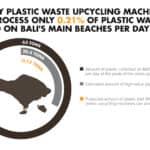Medical equipment like pulse oximeters, ECG monitors, anesthesia machines and oxygen concentrators are essential for diagnosing and treating patients. Sadly, the majority of this lifesaving medical equipment sits unused in low-income countries. The equipment sits idle in the hallways and closets of resource-strapped hospitals — often referred to as equipment graveyards. This largely stems from a lack of coordination and inefficiencies in donations. In this blog series, I explore how a blockchain-driven medical equipment donation platform might overcome these inefficiencies.
From 1997 to 2001 the World Bank invested $1.5 billion in medical devices, but found instances where 30 percent of the sophisticated equipment remained unused in the countries that received them. In some countries, as much as 80 percent of medical equipment is donated, or funded by international donors or foreign governments. However, according to the World Health Organization (WHO) and other sources, between 40 percent and 70 percent of the equipment is out of service.
This is not a new problem. Over the years it has been reported widely, including on NextBillion. In 2018, a National Academy of Sciences-led public private partnership group published recommendations for increasing the sustainability of medical devices in low-income countries. At the WHO’s Fourth Global Forum on Medical Devices, where I gave a plenary talk on the topic, the systemic issues that result in equipment graveyards were top of mind for many attendees. These issues include donors shipping inappropriate or broken equipment, lack of expertise in the donated country to maintain and repair the equipment, poor access to supplies and parts, challenges with coordinating among donors and failure to finance the cost of operating the equipment.
Enter blockchain. Blockchain (not to be confused with bitcoin) has been touted as a revolutionary technology, and there’s a lot of excitement about its potential. I am not going to dive into the details of how blockchain works here – check out the resources at these links for explanations of the technology and its global development uses. Suffice it to say that at a high level, blockchain makes it possible for no single entity to own data, while making that data tamper-proof but accessible to anyone approved to see it. Blockchain also uses tokens and smart contracts to create and extract value for an asset or service. As a result of these benefits, blockchain use cases are being explored in healthcare, real estate, energy and charity.
When it comes to medical equipment graveyards, a blockchain-based medical equipment donation platform could help with the problem. It could make the donation of medical equipment more efficient, increase the sustainability of this equipment, and open new channels for businesses to create and extract economic and social value. Let’s explore three common problems with the current medical equipment donation system, and how a blockchain-driven platform could help.
Problem 1: Medical equipment donations are fragmented
Multiple stakeholder groups (e.g. medical device manufacturers, medical equipment resellers, medical supply recovery organizations, government import/export agencies, etc.) are involved in medical equipment donations (see the ecosystem map below). They have limited understanding of each other’s roles and activities. This leads to confusion, duplication of effort, and recipients getting unwanted or incompatible medical equipment. Imagine having to operate and maintain five different models of ultrasound machines, where each model has a different user interface and uses a unique type of probe. Maintaining a mishmash of equipment is nearly impossible for resource-strapped healthcare providers.
Solution: Blockchain can bring together all the medical equipment donation stakeholders. Through a blockchain-driven platform, stakeholders could access data on medical equipment requests, shipments and donation activities. Stakeholders could use this information to coordinate with one another, pool their resources to cut down on duplication, and divert their efforts to areas that are underserved. Furthermore, since there is no globally recognized body that regulates medical equipment donations, blockchain can enable these stakeholders to organically form a decentralized consortium and allow participants to self-regulate. By creating transparency and accountability, such a platform would expand how stakeholders can operate in the ecosystem without the need for a central authority. This coordination alone could greatly improve the medical equipment donation supply chain.

Medical Equipment Donation Ecosystem (Source: Compton et al., National Academy of Medicine, 2018)
Problem 2: Donated medical equipment is either broken or inappropriate
Donated medical equipment can be new, but often it’s used and its condition can vary widely – from almost new to end-of-its-lifespan. Second-hand equipment is sent without testing to check if it works and without consideration of power requirements. The equipment may be missing the user manuals, adapters or consumables necessary to operate it. Recipients don’t know about the equipment’s condition until they receive it: Then, if they don’t have the resources to pay for returning it, repairing it or disposing of it, they are stuck with it. The equipment either sits unused in the hospital or gets discarded in landfills.
Solution: Blockchain can bring digital certification to the medical equipment being donated. For example, only equipment that is operational, includes manuals and meets the country’s power supply ratings would be certified for donation. The certification would give recipients assurance that the equipment will work. Suppliers of donated medical equipment and resellers of second-hand equipment would be more likely to take extra steps to ensure that the equipment is operational before sending it to recipients, in order avoid damage to their reputations. Ensuring that the donated equipment is working and can be put to use before it’s shipped would curtail the propagation of equipment graveyards.
Problem 3: Donors know little about the impact of their medical equipment donations
Donated medical equipment is usually not tracked after it leaves donors, so they have no idea about their donation’s impact on the recipient. Sometimes the donated equipment can sit in a warehouse in the U.S. for years and never make it to the recipient. Not knowing how their donations are benefiting the recipients not only frustrates donors, but also discourages them from making further donations.
Solution: Blockchain can allow donors to monitor the flow of their donations and measure their impact. The equipment’s progress along the journey from donor to recipient could be captured and logged onto the blockchain. Donation contracts could be programmed in the blockchain so that only those recipients who report on usage become eligible to receive donations in the future. Hospitals and medical device manufacturers that donate equipment could report on their corporate social responsibility with greater accuracy and confidence.
Challenges to These Solutions
Blockchain only works when the interests of different stakeholder groups are aligned, and the groups can agree on the rules that govern them. But given the current system’s dynamics, the stakeholders behind medical equipment donations may not clamor to sign up for a common blockchain-driven platform.
For one reason, medical equipment manufacturers, medical supply recovery organizations, government import/export agencies and development assistance agencies have different objectives and incentives, so not everyone sees eye to eye. What’s more, in the absence of a global coordinating body for medical equipment donation that has the influence and power to wrangle these stakeholders together, there is no incentive for the current players to voluntarily come together.
Another barrier is the lack of motivation for recipients of donated medical equipment to use a blockchain platform on an ongoing basis. Currently recipients have little incentive to report back on equipment usage. It’s understandable that they would choose to focus their efforts more on serving patients than carrying out time-consuming administrative tasks for data collection and reporting.
That said, one of blockchain’s advantages is its ability to link incentives using tokens for aligning disparate stakeholder interests. In my next article I’ll take a look at how tokens can nudge these stakeholders to come onboard, and open up a new market for medical equipment manufacturers, resellers and service providers to reach recipients.
This series of articles is intended to start a conversation that I hope will challenge the assumptions made here, generating new perspectives and ultimately yielding insights that can increase the sustainability of medical equipment in low-income countries. I welcome your comments and questions.
Vikas Meka is a consultant focusing on finding solutions that improve health for people in low-resourced settings.
Image provided by author.
You May Also Be Interested In:
Source: NextBillion

 From Trash to Resource: How Technology Can Help…
From Trash to Resource: How Technology Can Help… Big Problem, Small Solution: Can Do-It-Yourself…
Big Problem, Small Solution: Can Do-It-Yourself… Weekly Roundup: PSI for Profit, a Slowing…
Weekly Roundup: PSI for Profit, a Slowing…